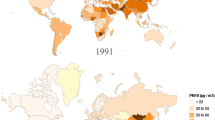Abstract
The European Operational Smog (EUROS) integrated air quality modelling system has been extended to model fine particulate matter (PM). From an extended literature study, the Caltech Atmospheric Chemistry Mechanism and the Model of Aerosol Dynamics, Reaction, Ionisation and Dissolution were selected and recently coupled to EUROS. Currently, modelling of mass and chemical composition of aerosols in two size fractions (PM2.5 and PM10–2.5) is possible. The chemical composition is expressed in terms of seven components: ammonium, nitrate, sulphate, elementary carbon, primary inorganic compounds, primary organic compounds and secondary organic compounds. Calculated PM10 concentrations and chemical composition are presented for two summer months of the year 2003 (1 July to 31 August).





Similar content being viewed by others
References
Capaldo, K. P., Pilinis, C., & Pandis, S. N. (2000). A computationally efficient hybrid approach for dynamic gas/aerosol transfer in air quality models. Atmospheric Environment, 34, 3617–3627.
Delobbe, L., Mensink, C., Schayes, G., Passelecq, Quinet, A., Ch., et al. (2002) BelEUROS: Implementation and extension of the EUROS model for policy support in Belgium, Global Change and Sustainable Development, 199-205. Brussels: Federal Science Policy Office.
Deutsch, F., Janssen, L., Vankerkom, J., Lefebre, F., Mensink, C., Fierens, F., et al. (2007) Modelling changes of aerosol compositions over Belgium and Europe. International Journal of Environment and Pollution, in press.
Fredenslund, A., Jones, R. L., & Prausnitz, J. M. (1975) Group-contribution estimation of activity coefficients in nonideal liquid mixtures. AIChE Journal, 21, 1086–1099.
Gery, M. W., Whitten, G. Z., Killus, J. P., & Dodge, M. C. (1989) A photochemical kinetics mechanism for urban and regional scale computer modeling. Journal of Geophysical Research, 94(D10), 12925–12956.
Griffin, R. J., Dabdub, D., & Seinfeld, J. H. (2002) Secondary organic aerosol 1. Atmospheric chemical mechanism for production of molecular constituents. Journal of Geophysical Research, 107(D17), 4332, doi:10.1029/2001JD000541.
McMurry, P. H., & Friedlander, S. K. (1979). New particle formation in the presence of an aerosol. Atmospheric Environment, 13, 1635–1651.
Meng, Z., Dabdub, D., & Seinfeld, J. H. (1998). Size-resolved and chemically resolved model of atmospheric aerosol dynamics. Journal of Geophysical Research, 103, 3419–3435.
Mensink, C., Delobbe, L., & Colles, A. (2002). A policy oriented model system for the assessment of long-term effects of emission reductions on ozone. In C. Borrego, & G. Schayes (Eds.), Air pollution modelling and its applications XV (pp. 3–11). Norwell: Kluwer Academic/Plenum Publishers.
Nenes, A., Pandis, S. N., & Pilinis, C. (1998). ISORROPIA: a new thermodynamic equilibrium model for multiphase multicomponent inorganic aerosols. Aquatic Geochemistry, 4, 123–152.
Pun, B. K., Griffin, R. J., Seigneur, C., & Seinfeld, J. H. (2002). Secondary organic aerosol 2. Thermodynamic model for gas/particle partitioning of molecular constituents. Journal of Geophysical Research, 107(D17), 4333.
Pun, B. K., Wu, S.-Y., & Seigneur, C. (2001). Contribution of biogenic emissions to the formation of ozone and partic-ulate matter: Modeling studies in the Nashville, Tennessee and Northeast domains, phase 2 report for CRC Project A-23, document number CP051-01-1. Alpharetta: Coordinating Research Council, Inc.
Saxena, P., Hildemann, L. M., McMurry, P. H., & Seinfeld, J. H. (1995). Organics alter hygroscopic behavior of atmospheric particles. Journal of Geophysical Research, 100, 18755–18770.
Sillanpää, M., Hillamo, R., Saarikoski, S., Frey, A., Pennanen, A., Makkonen, U., et al. (2006). Chemical composition and mass closure of particulate matter at six urban sites in Europe. Atmospheric Environment, 40, S212–S223.
Vestreng, V., Adams, M., & Goodwin, J. (2004). Inventory review 2004, emission data reported to CLRTAP and under the NEC directive, EMEP/EEA joint review report, EMEP/MSC-W Note 1/2004, ISSN 0804-2446.
VMM (2004a). Lozingen in de lucht 1990–2003, Vlaamse Milieumaatschappij, Aalst, Belgium (in Dutch).
VMM (2004b). Luchtkwaliteit in het Vlaamse Gewest—2003, Vlaamse Milieumaatschappij, Aalst, Belgium (in Dutch).
Zhang, Y., Pun, B., Vijayaraghavan, K., Wu, S.-Y., Seigneur, C., Pandis, S. N., et al. (2004). Development and application of the model of aerosol dynamics, reaction, ionization, and dissolution (MADRID). Journal of Geophysical Research, 109, D01202, doi:10.1029/2003JD003501.
Acknowledgements
The authors wish to thank Robert Griffin (University of New Hampshire, Durham) and Donald Dabdub (University of California, Irvine) for providing them with the source code of the CACM chemical mechanism and for helpful discussions and comments during the implementation of the mechanism. We also wish to thank Christian Seigneur and Betty Pun (Atmospheric and Environmental Research, San Ramon, CA) for providing us with the source code of the aerosol module MADRID 2 and for their helpfulness during the implementation phase.
Author information
Authors and Affiliations
Corresponding author
Rights and permissions
About this article
Cite this article
Deutsch, F., Vankerkom, J., Janssen, L. et al. Extension of the EUROS Integrated Air Quality Model to Fine Particulate Matter by Coupling to CACM/MADRID 2. Environ Model Assess 13, 431–437 (2008). https://doi.org/10.1007/s10666-007-9100-z
Received:
Accepted:
Published:
Issue Date:
DOI: https://doi.org/10.1007/s10666-007-9100-z




